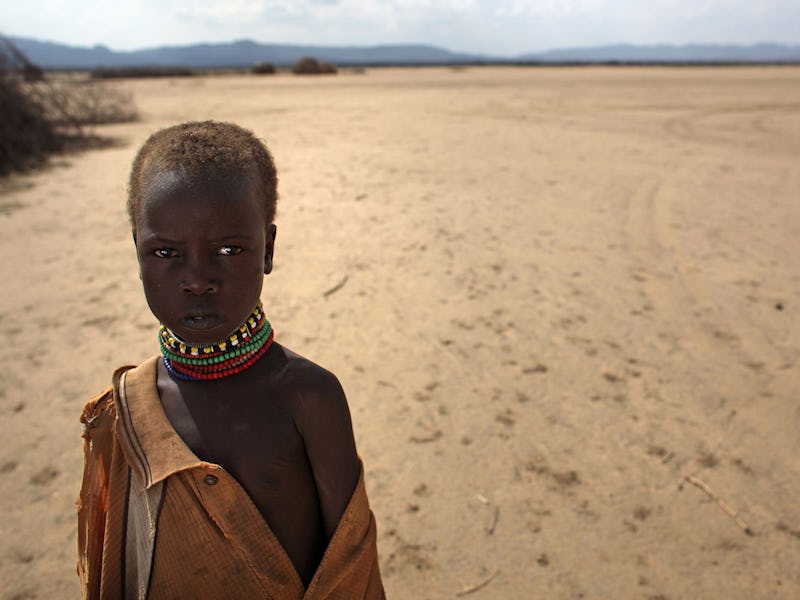Prepare for 100 Million People Forced Into Poverty in 2030 by Climate Change
The social safety net needs to be able to catch a lot more people.

Poverty and climate change: two massive, complex issues that naturally bring legislation to a grinding halt, even as research urging us to make drastic changes quickly piles up.
So there’s a fearful symmetry to a World Bank prediction report published over the weekend that as many as 100 million people will be pushed into extreme poverty as a result of climate change in the next 15 years.
“Only immediate emissions-reduction policies can limit the long-term impacts of climate change on the poor,” the report states.
The report, Shock Waves: Managing the Impacts of Climate Change on Poverty, suggests we’re on the brink of a catastrophic avalanche of disease and food scarcity, and the world’s poor are the least-prepared for it.
Tellingly, the report doesn’t give any advice on how to prevent any of these changes because it’s already way too late for any global plan to instill meaningful change. Rather, it asks us to firm up the social safety nets. So that’s something else our world leaders can chew over when they meet later this month in Paris for the UN’s climate change conference.
From the report’s foreword:
“Our studies show that without action, climate change would likely spark higher agricultural prices and could threaten food security in poorer regions such as Sub-Saharan Africa and South Asia. And in most countries where we have data, poor urban households are more exposed to floods than the average urban population.”
“Climate change also will magnify many threats to health, as poor people are more susceptible to climate-related diseases such as malaria and diarrhea. As the report points out, poverty reduction is not a one-way street. Many people exit or fall back into poverty each year. The poor live in uncertainty, just one natural disaster away from losing everything they have.”
The World Bank defines extreme poverty as living on $1.25 a day. While roughly half the citizens in the developing world were classified as living in extreme poverty in 1981, we got that number down to 21 percent by 2010, according to a World Bank poverty overview. That still left about 1.2 billion globally in extreme poverty as of 2014.
A big problem for those struggling on the edge is going to be the lower crop yields leading to higher food prices. As malnutrition spreads and water dries up, you can expect a host of expensive health problems to follow, from malaria to diarrhea to stunted development.
Again, the World Bank suggests we need to focus on managing this as much as slowing it:
“Just how large might these impacts be on poverty by 2030 and how much can development help? We know that between now and then, climate policies will have minimal impacts on warming, given the long lag between the introduction of mitigation policies, their impact on emissions, and the effect of emissions reductions on the climate system (IPCC 2014).”
Great, so:
“This means that, by 2030, the only way to reduce climate change impacts will be by lowering socioeconomic vulnerability to these impacts — which will require climate-informed development and specific actions to adapt to climate change.”
Yet even this is optimistic when you consider that we’re already confronting the impact of climate change tumbling the underclass across the globe in 2015. In September, Elon Musk said we needed to be on guard for hundreds of millions of refugees displaced by climate change in Germany, at the same time as the country was accepting train cars stuffed with fleeing Syrians.
They may not have had to escape a political conflict that left half the population of 22 million displaced and about 200,000 dead if it hadn’t been for the punishing drought. Take the word of Francesco Femia, founder and director of the Center for Climate and Security, speaking to The New York Times: “There’s no question that the drought had a role to play in the mass displacement of people.”
Or break it down to even more mundane daily life in any major city. A 2014 study from Harvard on heat-related mortality in New York City found that poorer neighbors suffered the effects of climate change at a greater level than wealthy ones because high-poverty neighborhoods tend to be warmer and richer ones cooler — they have fewer trees, and the buildings are made with cheaper material that tends to retain more heat, and people are more likely to have jobs that require them to work outside in the heat. You could see the results of that in the disparity of rates for senior mortality rates linked to heat-related health issues.
Those neighborhoods won’t get any cooler when another 100 million people move in.